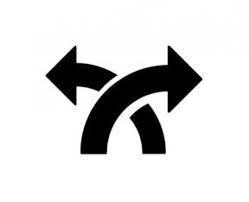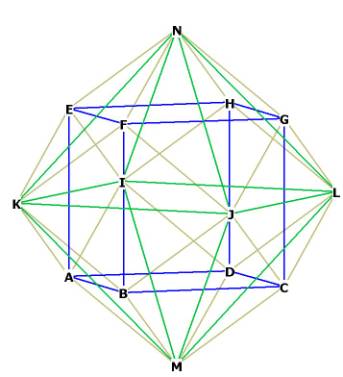|
(2017
midterm assignment) Model Student Midterm answers 2017 (Index) Essay 1: Compare, contrast, and evaluate Narratives of the Future |
 |
Clark Omo
Futuristic Anxieties: Examining the Exploration of Fear and Anxiety in
Literature of the Future
At
this point in the semester, the selected Literature of the Future has so far
covered three narratives of the Future: Creation/Apocalypse, Evolution, and
Alternate History. For Creation/Apocalypse, we were introduced to this narrative
through the Books of Revelation and Genesis, along with the novel,
The Parable of the Sower. For
Evolution, we explored H.G. Wells’s The
Time Machine and “Somebody Up There Likes Me”, and for Alternate History we
were given a variety of short stories such as “Mozart in Mirror-shades” and “The
Garden of Forking Paths”. Though varied greatly in approach to each of these
individual subjects, all of these stories, as well as the narratives, have
something in common; they all approach and examine anxieties and fears
concerning the future, and thus reflect the dread that overshadows the
consequences that accompany present decisions. For Creation/Apocalypse, the fear
is that the current state of civilization is in decline, and thus will reach its
terminus in the form of total destruction. For Evolution, there is hope that man
will eventually find a way to evolve out of his current dilapidated state to a
point of utopian perfection, yet at the same time certain crucial and beneficial
traits will be lost. And for Alternate History, multiple choices and
possibilities are presented at once within the same instantaneous moment of
time, yet there is no way as to determine which one is the best. Throughout all
three of these narratives exist this fear of the unknown, and this fear is what
guides these narratives, as well as explains their purpose within the chosen
stories.
The
Creation/Apocalypse Narrative explores this fear in the most blatant way: the
Apocalypse. This Narrative follows the pattern as such: man is created and given
residence with a perfect and serene environment, not at all under threat from
decay or corruption. However, this peaceful state is soon violated and
decimated, resulting in the current state in which the protagonist finds him or
herself, and then is capped off by a purifying event of total and mass
destruction. The fear experience in such a narrative is readily apparent, and
can be seen in such works as Revelation, where the entire book consists of
nothing less than fire and judgement, and at last perfection at the end. This
idea, of course, creates anxiety: will there be such an Apocalypse, are we in
such as state of decline that would justify an event like this, and (perhaps
most importantly) is there hope? Revelation says there is, and it comes in the
form of the New Jerusalem. Similarly, The
Parable of the Sower also follows this Creation/Apocalyptic Narrative, in
which it also looks forward to state of utopian safety. As the story begins, the
audience is introduced to Lauren and her town that just so happens to be
isolated from the decay outside (gangs, bandits, etc.), much like a sort of
Edenic Paradise. However, the state of this paradise is far from secure:
countless times does Lauren express her concern that their situation is only
worsening. As Lauren admits to her
father, “It’s getting worse, Dad” (66), to which her father replies, “I know”.
Both Lauren and her father know that the end will come eventually; that the
world around them will be shattered and they will have to find the ways and
means of survival in a tremendously unsafe and insecure world. Clearly there is
anxiety in such language and responses: fear of the oncoming apocalypse.
This
anxiety regarding future consequences is also present within the Evolution
narrative as well. The Time Machine
illustrates such fear of the future as thus when he travels some several
millennia forward into time to find man rendered into a class separated society
dominated by two distinct groups: the Eloi and the Morlocks. The Eloi, as the
Time Traveler observes, are passive and meek: the future of human evolution, as
the Time Traveler at first concludes. Yet, conversely, the Eloi’s representation
as a future stage of human evolution is not an appealing one; for instance, they
lack even the smallest inkling of sympathy for those of their own race,
evidenced by how they watch with disinterest as Weena rushes to her death in the
rapids of the river. The Time Traveler, in the later course of the story,
discovers that in fact the Eloi are serving as nothing more than “cattle” to be
nourished so they can function as “fatted cattle”, so to speak, by the Morlocks
who then make a meal from their flesh. As a result, the Eloi live in terror of
dark places and the night itself. Interestingly, in contrast, the Morlocks
themselves have an extreme fear of light. Humanity in
The Time Machine may have evolved to
some extent: the Eloi’s environment does seem peaceful and without need for any
major sort of technology to aid in living (at least superficially). But this
evolution has also left them weak and devoid of care (one may dare say they are
without Love, to an extent). Evolution, therefore, does not promise progress in
its cyclical progress: it also brings with it devolution, evidenced by
The Time Machine. This is anxiety,
for even though man may continue to “evolve” into a better and more perfect sort
of being, we are just as likely to lose the most basic and essential
characteristics that define us as humans.
The
story “Somebody Up There Likes” me also expresses a fear of the future, even
though technology is evolving and advancing. The protagonist of this piece,
Dante, laments regarding the evolution of his own students, “My students
implanted digital watches in the skin of their wrists, tattooed and barbered
themselves so as not to appear human…” As the world advances around him, Dante
is steadily becoming disconnected and the definition of what it means to at
least appear human is being changed.
The anxiety regarding the future is clear in this story, for as society and
culture seem to advance before eyes, those thing that may been better are in
danger of being lost. This is what Dante feels, but even he realizes that the
advancements may not all be bad, for he does succumb to obtaining a Revelation
2000, the newest and most hi-tech computer on the market. Yet, still, some
things are being lost, and Dante feels, as some of this story’s audience must
feel, as though things are slipping away.
The
consequences of such advancements (which is another branch of this anxiety
regarding the future) is also explored through the Alternate History narrative.
The story “Mozart in Mirror-shades” illustrates this anxiety with future
decisions well, for its own setting is one of multiple realities where different
decisions are made. Rice (the protagonist) lives in a world where his own
timeline has run out of oil, and thus the powers that be have decided to go back
in time and crossover to alternate realities where there is still oil. The
reality they have chosen is in fact one where Thomas Jefferson obtained the
title of being the first President of the United States, opposed to George
Washington. And throughout this story we are assaulted with images of the
consequences of making such a decision as taking the resources from a separate
timeline. There are protests led by Comanches against oil derricks, and a Marie
Antoinette that yearns for a bikini. Mozart himself is altered as well, to the
point he has no interest in making music. This series of events and alterations
serve as reflections of the infinite amount of possibilities that face humanity
regarding its future. Each decision has in turn an effect, and each effect, in
turn, has a consequence. And it is these consequences that frighten humanity,
for, since our knowledge is infinitely limited, we can never know whether the
decisions made now are truly the ones that will bring the most benefit. There
could be unforeseen consequences to everything ever thought or done. Thus, the
world of “Mozart in Mirror-shades” is fraught with rebellion, exploitation, and
bizarre anachronisms: the results of choosing to alter one timeline’s past in
order to save another’s future.
Speaking of paths, another story that explores this narrative as well as the
fears and anxieties held within it is the “Garden of Forking Paths”. In this
story, the audience is looking through the eyes of the protagonist, a spy for
the Germans during WWI, on assignment in Britain. Once the spy runs from his
pursuers and eventually arrives in the home of Dr. Stephen Albert, the audience
is given another glimpse into the possibilities and consequences making separate
decisions. This story, however, takes a more theoretical than physical approach
compared to “Mozart in Mirror-shades”, though it nonetheless expresses the same
anxiety so far covered in this paper. As the protagonist converses with Dr.
Albert, he learns that the Doctor has in his possession a volume of the work,
The Garden of Forking Paths, written
by the protagonist’s ancestor. In this book, multiple fates and actions are
illustrated for the story’s hero; as the protagonist relates, “in the third
chapter the hero dies, in the fourth he is alive.” Thus, this book examines the
possibility of alternate futures, with each future hinged upon the decisions
made by the central character. And to complicate things even further, the book
does not simply present each alternate future as a possibility, but rather as a
kind of branching network where every
future happens at once.
This
is mind-blowingly complex from just a critical standpoint upon narrative. To
think of experiencing all the possible consequences of our actions and every
future they would result in within the same and single moment of time is as
staggering to the human mind as it is reflective. Would knowing all our possible
futures have any sort of influence upon how we make decisions? It seems so for
the protagonist, for as Dr. Albert explains: “…in one of the possible pasts you
are my enemy, in another, my friend.” And so, the protagonist later shoots
Albert out of response to this very possibility. And then, as the story ends,
multiple futures unfold for the protagonist at once: one where he is arrested,
another when he is successful in his mission. As demonstrated by the “Garden of
Forking Paths” there exists an anxiety within the truth that one action could
have multiple consequences, depending upon which path one follows. Such is the
purpose of the Alternate History Narrative: to explore the possibilities of what
would happen if humanity’s decisions as well as history had taken a different
course, thus reflecting the anxiety and fear of what could (or even
should) have happened.
The
three Narratives of the Future certainly explore what they are named for: the
future. And by doing so, they explore the fears and anxieties often associated
with what may come to pass. For Creation/Apocalypse, there is the fear of the
Apocalypse itself. For so it seems that, even when allowed to exist within an
initial state of perpetual perfection and peace, corruption and inevitable
destruction do come. As Eden was perfect, it fell to the wiles of Satan. Same is
true in The Parable of the Sower.
Though Lauren lives in a place that is not totally safe, it is nonetheless
Edenic with its promises of protection and preservation of family. Yet, its very
walls come crashing down in fire, redolent of the Last Days in Revelation. This
same fear is present in the Evolution Narrative as well, such as in
The Time Machine where the Time
Traveler travels to time where humans seem to have evolved out of their own
humanity. And furthermore, the Alternate History Narrative explores the same
fears, for it presents its audiences with the possible consequences if decisions
had been made differently. Such is the state of Literature of the Future:
literature of ideas regarding fear of the future. And thus, by exploring these
fears, we who dare read these works see manifest the dark fact that, truly, the
future is by decree unforeseeable.
 |
 |
 |
